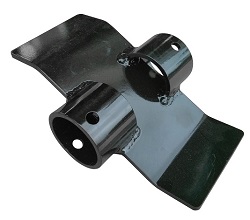OPERATING THE LAKE GROOMER IN MUCK
TIPS AND IMPORTANT OPERATING INSTRUCTIONS FOR OPERATING THE LAKE GROOMER IN DEEP MUCK & SEDIMENT
Depending on the amount of muck depth on your lake bed, the lake weed rollers may get stuck in the muck. If this happens, there are a few different removal options that will need to be considered. Sediment deposits on the bottom of your beach can result in a reaction similar to what happens to any vehicle when it gets stuck in the mud. In this case, the rollers are the wheels of the Lake Groomer. The deeper the muck or the longer the unit spins, the harder it will be to get unstuck and the resulting stress may cause damage to the unit.
It is recommended to start closer to shore and clear the muck slowly in segments. As the area begins to clear, increase the travel. For example, we encourage customers dealing with mucky conditions over 5-6 inches to start by the shore line. Adjust the path in order to clear the area with muck less than 5- 6 inches, so it may be only in 30, 45, 60 degree path to start out.
It is also a good idea to help the Lake Groomer deal with the depth of muck by pulling the deeper muck into cleared areas to help expedite the seaweed & silt removal process. A beach rake such as our Long Reach Lake Rake is a good tool for this job. You will notice the unit firms up the lake bottom after it runs for awhile.
TIP: If you have a lot of muck and/or only have muck that you are trying to get rid of, our AquaThruster is guaranteed to help!
A Mud Paddle is also available to aid in driving through muck, but is sometimes limited by the depth of the muck in extreme conditions. The paddle will also need to be removed when the muck is decreased, since running the unit with the mud paddle with little or no muck will damage the paddle and possibly the Lake Groomer.
When your Lake Groomer is not in use, make sure to never park the rollers in the muck. Muck will find its way inside the tubes, making them very heavy and difficult to turn, which can cause parts to fail or break. It increases the wear on the coupler joints and may cause premature failure of the roller coupler assembly components.
If you are starting with more than the standard 3 rollers, it’s important to note that it may be necessary to limit the amount of rollers when first clearing the area of muck. It’s more important to reduce the arc as we explain below.
Dropping the unit at the end of the dock in deep muck is a recipe for trouble. If you know the muck is not an issue on your beach bottom then it isn't an issue to proceed to wherever you want to set it up.
It is always wise to watch the rollers as they are making the first few passes to ensure they are not spinning in place. In some mucky conditions the rollers will dig themselves in deeper muck and get stuck. They can be very difficult to get unstuck when left running or set in place for a long time. If you watch the weed removal rollers, and you see they aren't progressing through the limit set, you should flip the toggle switch so the rollers reverse and back out of the muck before they get stuck. If diligent, this can also be used to determine the ideal set-up for muck clearance. When the water clarity prevents you from seeing the rollers in the water, you can watch the communication tube decal or the set screw on the base of the directional puck to see if the rollers are moving across the lake bed.
Please contact Weeders Digest support with further questions about the Lake Groomer or visit the Lake Groomer Page.
Recent Posts
-
4th of July Lakefront Checklist: Get Celebration-Ready in Just a Few Days
The fireworks may be the main event, but if you're hosting at the lake this 4th of July, your shorel …24th Jun 2025 -
5 Ways to Turn Your Lake Property Into a Summer Retreat
5 Ways to Turn Your Lake Property Into a Summer Retreat For many lakefront property owners, the goal …5th Jun 2025 -
The Complete Checklist for a Clean and Safe Lakefront
A well-maintained lakefront doesn’t just look better, it performs better. Whether your shoreli …3rd Jun 2025





